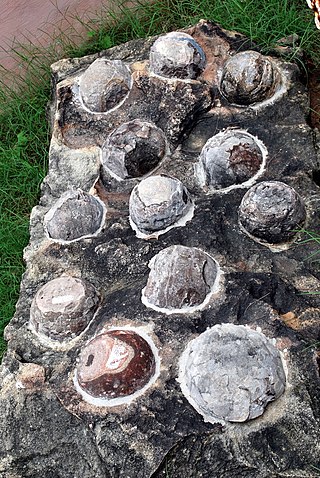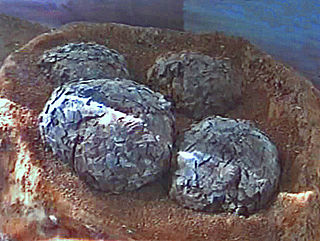
Dinosaur eggs are the organic vessels in which a dinosaur embryo develops. When the first scientifically documented remains of non-avian dinosaurs were being described in England during the 1820s, it was presumed that dinosaurs had laid eggs because they were reptiles. In 1859, the first scientifically documented dinosaur egg fossils were discovered in France by Jean-Jacques Poech, although they were mistaken for giant bird eggs.

Cairanoolithus is an oogenus of dinosaur egg which is found in Southwestern Europe. The eggs are large and spherical. Their outer surface is either smooth, or covered with a subdued pattern of ridges interspersed with pits and grooves. Multiple fossil egg clutches are known but the nest structure is unclear.

Megaloolithus is an oogenus of dinosaur egg. They are thought to have been laid by sauropod dinosaurs. They are known for having thick eggshells, at least 1.5 millimetres (0.059 in) thick, and the nearly spherical shape of the eggs. They are primarily found in India and Europe, but some specimens have been found in South America.
Sphaerovum is an oogenus of dinosaur egg that has only been discovered in South America.

Ovaloolithus is an oogenus of dinosaur egg. Eggs of the genus have been found in China, Mongolia and Utah.
Shixingoolithus is an oogenus of dinosaur egg from the Cretaceous of Nanxiong, China.

Spheroolithus is an oogenus of dinosaur egg.
Protoceratopsidovum is an oogenus of dinosaur egg from Mongolia. Despite its name, it does not represent the eggs of a protoceratopsid, but rather the eggs of maniraptoran theropods.
Pseudogeckoolithus is an oogenus of dinosaur egg. It is known from several fragments of eggshells. The outer surface of these are covered with little knobs and nodes. Some of the pores in the eggshell open through these nodes, similar to modern geckos, but unique among the dinosauroid-prismatic group of eggs. However, the microstructure of Pseudogeckoolithus shows that it is not actually of the geckoid type. It is possible that these eggs represent a new basic group of fossil eggs.

Macroolithus is an oogenus of dinosaur egg belonging to the oofamily Elongatoolithidae. The type oospecies, M. rugustus, was originally described under the now-defunct oogenus name Oolithes. Three other oospecies are known: M. yaotunensis, M. mutabilis, and M. lashuyuanensis. They are relatively large, elongated eggs with a two-layered eggshell. Their nests consist of large, concentric rings of paired eggs. There is evidence of blue-green pigmentation in its shell, which may have helped camouflage the nests.
Phaceloolithus is an oogenus of dinosaur egg found in the Fenshui'ao Formation of the Dongting Basin of the Hunan Province of China. The eggs have a subspherical shape, measuring up to 168 mm on the long axis, and having a very thin shell.
Subtiliolithus is an oogenus of fossil egg from the Nemegt Formation of Mongolia and the Ohyamashimo Formation of Japan. The eggs are notable for a very thin eggshell. It contains three oospecies: S. hyogoensis, S. kachchhensis and S. microtuberculatus. They were originally classified as a distinct oofamily, Subtiliolithidae, but numerous similarities to Laevisoolithus have led to their reclassification as Laevisoolithid eggs. A complete skeleton of Nanantius valifanovi was found associated with Subtiliolithus eggshells, indicating that the oogenus represents eggs of enantiornithine birds.
Continuoolithus is an oogenus of dinosaur egg found in the late Cretaceous of North America. It is most commonly known from the late Campanian of Alberta and Montana, but specimens have also been found dating to the older Santonian and the younger Maastrichtian. It was laid by an unknown type of theropod. These small eggs are similar to the eggs of oviraptorid dinosaurs, but have a distinctive type of ornamentation.
Dispersituberoolithus is an oogenus of fossil egg, which may have been laid by a bird or non-avian theropod.

Egg fossils are the fossilized remains of eggs laid by ancient animals. As evidence of the physiological processes of an animal, egg fossils are considered a type of trace fossil. Under rare circumstances a fossil egg may preserve the remains of the once-developing embryo inside, in which case it also contains body fossils. A wide variety of different animal groups laid eggs that are now preserved in the fossil record beginning in the Paleozoic. Examples include invertebrates like ammonoids as well as vertebrates like fishes, possible amphibians, and reptiles. The latter group includes the many dinosaur eggs that have been recovered from Mesozoic strata. Since the organism responsible for laying any given egg fossil is frequently unknown, scientists classify eggs using a parallel system of taxonomy separate from but modeled after the Linnaean system. This "parataxonomy" is called veterovata.

Egg paleopathology is the study of evidence for illness, injury, and deformity in fossilized eggs. A variety of pathological conditions afflicting eggs have been documented in the fossil record. Examples include eggshell of abnormal thickness and fossil eggs with multiple layers of eggshell. The identification of egg paleopathologies is complicated by the fact that even healthy eggs can be modified during or after fossilization. Paleontologists can use techniques like cathodoluminescence or thin sectioning to identify true paleopathologies in fossil eggs. Despite the diversity of paleopathologies known from fossil eggs, the vast majority of conditions known to afflict modern eggs have not yet been seen among fossils.
Reptile egg fossils are the fossilized remains of eggs laid by reptiles. The fossil record of reptile eggs goes back at least as far as the Early Permian. However, since the earliest reptile eggs probably had soft shells with little preservation potential, reptilian eggs may go back significantly farther than their fossil record. Many ancient reptile groups are known from egg fossils including crocodilians, dinosaurs, and turtles. Some ancient reptiles are known to have given live birth and are therefore not anticipated to have left behind egg fossils.
Guegoolithus is an oogenus of fossil egg from the early Cretaceous of Spain. It is classified in the oofamily Spheroolithidae, and was probably laid by an ornithopod dinosaur.
Trigonoolithus is an oogenus of dinosaur egg, representing a basal prismatoolithid. Its eggshell, like avian eggs, is composed of three structural layers, but cladistic analysis suggests that its parent was a non-avian theropod.
Nanhsiungoolithus is an oogenus of dinosaur egg from the late Cretaceous of China. It belongs to the oofamily Elongatoolithidae, which means that it was probably laid by an oviraptorosaur, though so far no skeletal remains have been discovered in association with Nanhsiungoolithus. The oogenus contains only a single described oospecies, N. chuetienensis. It is fairly rare, only being know from two partially preserved nests and a few eggshell fragments.






